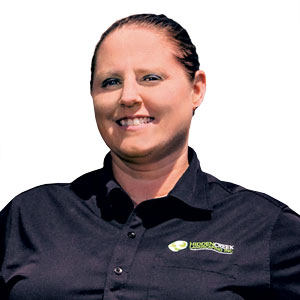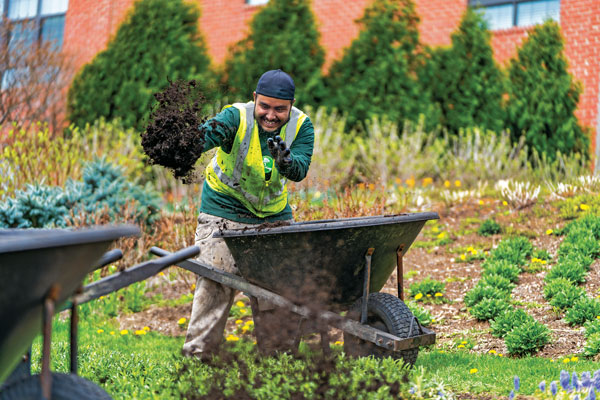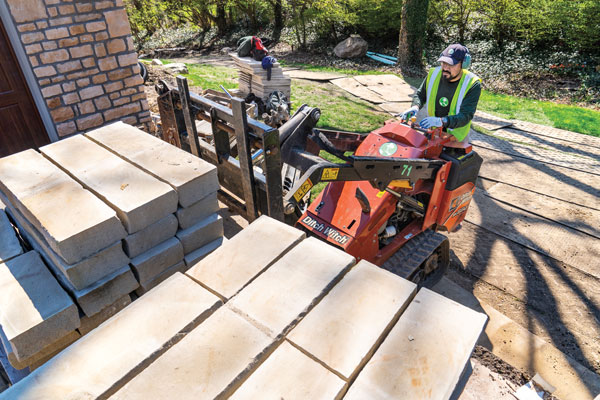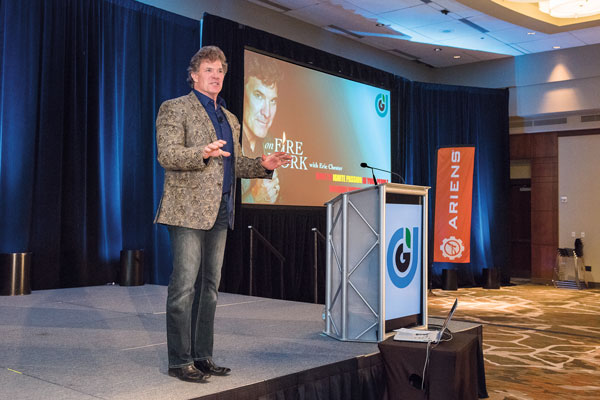
In the face of dwindling H-2B acceptances, fewer enrollments in horticulture programs and the ongoing search for qualified workers — the National Association of Landscape Professionals (NALP) hopes to promote the landscaping industry as an attractive career option and help add 100,000 jobs to the industry. Here, we explore how landscape companies, national associations and green industry manufacturers are working to find solutions and get more people to work in the field of landscaping.
High school and college recruitment
Start them young
Gail Reinhart took a long road to her career in the landscaping business. After a couple years in college, she found work in a car parts factory near her hometown of Findlay, Ohio, left that job to become a park ranger and then moved on to golf course maintenance.
She earned her associate degree in landscape and turf management and started in the industry as a maintenance technician.

Nearly 20 years into her landscaping career, and now the recruitment and personnel specialist at Hidden Creek Landscaping, Reinhart aims to help others find a shorter path to a green industry career — by showing high school students the opportunities the industry can offer.
Hidden Creek Landscaping is based in Hilliard, Ohio, and has 105 employees, including 30 through the H-2B visa program. Hidden Creek provides 40 percent landscape maintenance and snow removal and 60 percent design/build services to a client base that is 55 percent commercial and 45 percent residential. The company’s revenue was approximately $12 million in 2018.
Reinhart says Hidden Creek has received its requested number of H-2B workers the last few years, but its goal is to reduce that number so it can hire more workers domestically.
In her nearly five years at the company, Reinhart has been instrumental in building its recruiting initiative. She forges relationships with career tech schools and schools with horticulture or FFA programs.

Recruiters aim to educate students on the opportunities for growth in the green industry. Photo: Marshall Evan Photography
“You have to put in the time and be on the advisory councils, you have to go to the schools to help train them for events, like FFA ones,” she says. “Offer your time to teach (students) about things like construction estimating — that goes a long way.”
She says it still shocks her how many landscape company recruiters aren’t investing in high school career tech programs, but she admits it’s a long-term game.
“You have students who are maybe only sophomores and you’re waiting for them to graduate — and maybe they decide that they’re going to go to college,” she says.
As for other recruitment initiatives, Hidden Creek intends to apply for the NALP apprenticeship program and become more involved with community organizations for veterans. It also supports the Ohio Nursery & Landscape Association’s Ohio High School Landscape Olympics.
Reinhart has observed that members of Generation Z (current high school-aged students) are interested in experiences. They want to be hands-on, and sustainability is important to them. Because of that, high school students are starting to see the benefit of a career outdoors.
“They’re interested in the outdoor world, and I see a lot of great potential there,” she says.
For Landscape Workshop, colleges have become a central focus of its recruitment efforts. The company is headquartered in Birmingham, Ala. and operates 10 other locations in Alabama and Tennessee.
With a revenue of more than $41 million in 2018, the company managed to grow by 20 percent over 2017, despite receiving 258 H-2B workers instead of the 305 workers it requested. H-2B accounts for nearly half of Landscape Workshop’s workforce and as long as the program is available, company officials say they will use it.
However, in the past three years, Landscape Workshop has scaled up its recruitment efforts closer to home. Elaine Anderson is one of two full-time talent recruitment specialists employed by Landscape Workshop.

Her main objective is outreach to colleges and technical schools in the Southeast, getting to know the faculty and partnering with universities. Auburn University and Mississippi State University are two of the colleges she has a strong relationship with, though she supports and coordinates with approximately 15 to 20 institutions. Throughout the fall semester, she attends career fairs, student organization events, horticulture department events and speaks to classes about the opportunities in the green industry. For the events she can’t attend, she’ll get the company’s name out in front of students by sponsoring the event and providing company swag and information for the student organization to distribute.
Anderson says this was a trial school year, with the company trying a variety of initiatives and mostly focusing on recruiting interns. So far, Landscape Workshop has added 10 summer interns and four new full-time field managers on staff for the summer.
Anderson says she would have preferred a few more field managers, but she is encouraged by the hires and the fact that the number of university hires is growing.
“That shows that it’s worth the time and intentionality, and that we’re doing some of the right things to attract students,” she says.
“A lot of the candidates we do meet are really impressive,” Anderson continues. “That’s encouraging in the sense that the leaders who are coming into the green industry are top quality and are passionate about what they want to pursue.”

Eric Chester, an author and keynote speaker on employee engagement and workplace culture, says storytelling is essential to attracting more people — including the younger generation — to the industry.
“Pride is the one thing that can’t be bought or sold — the pride that comes with a job well done,” he says. “Why not talk about pride and meaningful contribution?”
Chester says the landscape industry can do a lot better at building a narrative and becoming a viable career option. And he has an affinity for the industry — he spent his spare time in high school and college working on a landscape crew.
He encourages companies to connect and build relationships with the people who have influence in schools, like teachers, academic advisers and counselors. For companies looking to hire veterans, he recommends building relationships in career centers and military organizations.
Chester offers a final takeaway for landscape company owners in the current labor climate: “Don’t assume this workforce is simply a younger version of you — don’t try to manage them the way you were managed.”
Understand the mentality of the current working generations, ask questions and do not be quick to judge, he adds.

NALP Workforce Summit and the Industry Growth Initiative
A landscape industry coalition
“A lot of the country is looking for a family-sustaining job and a career path — and that’s what you’re offering,” U.S. Dept. of Labor Chief of Staff Nick Geale said to a crowd of 130 green industry company owners, HR professionals and senior managers at the NALP Workforce Summit.
NALP assembled the first-ever summit in Washington, D.C., in February, engaging the industry in a series of discussions about bringing more jobs to the field of landscaping.
The Dept. of Labor’s Bureau of Labor Statistics expects occupational employment in the industry to grow 11 percent over the next ten years. NALP hopes to help keep pace with this growth by adding 100,000 jobs to the industry by 2025. Through the Industry Growth Initiative (IGI), which is led by the association’s Foundation Board, the association campaigns to raise the profile of the industry.

Frank Mariani, CEO of Frank Mariani Landscape in Lake Bluff, Ill., is NALP Foundation president. When he joined the board a few years ago, the primary goal of the foundation was to raise money for scholarships in the industry.
“It became painfully obvious that that was not enough — a lot of these schools were having a hard time getting students to take green industry-related classes — horticulture classes, landscape architecture classes,” he says.
The IGI was born. “It’s kind of a ‘Got Milk?’ campaign to let not only students, but parents, know that you can make an investment in a school where your kid can come out and join the green industry,” Mariani says.
It’s a means to convey what encompasses the industry — for example, running a major operation like $2 billion BrightView — and opportunities available at companies connected to the industry, like John Deere, he adds.
Mariani is particularly enthusiastic about the possibilities of the new landscape apprenticeship program. “We’re really excited about that — we’ll be able to work with high schools, junior colleges, colleges and people reentering the workforce. That will do much to raise awareness for this great industry.”
The Landscape Management Apprenticeship Program was created in early 2019 and is sanctioned by the Dept. of Labor. NALP explains that employers offering apprenticeships will have an edge in recruiting, hiring and receiving tax credits. Apprentices must be at least 16, have a diploma or be working to complete high school. The program includes 2,000 hours of training in 17 competency areas, 144 hours of classroom instruction and the opportunity to earn college credit upon completing the program.

Missy Henriksen, NALP’s vice president of public affairs, says interest and activity has coalesced around the new apprenticeship program. She has examples of companies in Georgia, New York and Pennsylvania that are using the apprenticeship program to start conversations with their local school systems and to draw positive publicity to the green industry.
Workforce boards were also a big topic of conversation at February’s Workforce Summit. A large portion of the group had never considered joining one or wasn’t aware they existed.
The U.S. has a network of 550 publicly/privately funded workforce boards that establish local job centers. These centers help employers across a range of industries find talent and assist with job training. NALP representatives recently attended the National Association of Workforce Boards’ conference and found that landscaping companies have been increasingly active in engaging with their local workforce boards to recruit labor.
“Our industry is starting to make noise and gain visibility with people that can help fill positions,” Henriksen says.
The activity on the part of landscape companies demonstrates that the Workforce Summit wasn’t simply a showcase meeting, says Henriksen. Some of the other initiatives in the works include the development of a Women in Landscape council to promote diversity and identifying women to lead that council.
“As people get really engaged, they begin to see the scope, breadth and depth of work being done by the IGI,” Henriksen says.

Green industry company support
Industry pros offer a helping hand

The day-to-day work of the green industry wouldn’t be possible without quality equipment to do the job, so it makes sense that equipment companies are essential in the efforts to develop the industry’s labor pool.
Caterpillar and LMN co-sponsored the Workforce Summit. According to John Janes, sales & marketing for Caterpillar, aside from the summit, the company’s workforce development efforts involve supporting state associations and leading universities with green industry programs. The company has also partnered with landscape companies on events, having recently hosted a recruiting event with Littleton, Colo.’s Designs by Sundown before the 2019 National Collegiate Landscape Competition (NCLC).
Janes says Caterpillar has seen a tremendous increase in landscape company investment in diesel-powered construction equipment, and it’s because landscape companies are deploying capital to replace labor because they can’t find workers.

From his perspective, a good takeaway from the labor shortage is the need for landscape companies to concentrate on operational efficiency.
“For some jobs, they don’t need as much labor as they thought they did,” he says.
Part of retaining qualified workers is providing ongoing training and development. Grow The Bench seeks to help landscape companies by offering online training that employees can complete at their own pace. “The lack of professional development is the No. 1 reason people leave companies,” says Phil Harwood, managing partner of Grow The Bench, citing a 2018 Gallup poll on workforce development.
“The effort to develop people and invest in them is really to attract people and hold onto them,” he adds. The company also collaborates with industry partners on recruitment and education efforts.

John Deere is actively involved in a variety of trade organizations: NALP, the Sports Turf Managers Association, the Professional Grounds Management Society and the National Hispanic Landscape Alliance.
Ken Taylor, sales manager, corporate business division for John Deere, says the company is a major sponsor of FFA and regularly communicates industry opportunities to FFA’s high school members. NCLC is a major event for John Deere, and it’s very involved with the 50-plus schools that participate.
John Deere continues to support NALP’s Industry Growth Initiative and workforce development efforts as well. “We’ve always been committed to companies and organizations that are linked to the land,” Taylor says. “What the industry does in developing and maintaining green spaces truly enhances the communities that we all live, work and play in. So at John Deere, giving back and supporting the industries that are core to our business, to me, just makes sense.”
Ignite employee engagement

It’s not enough to simply recruit; retention is also a large part of the labor problem. In his book, “On Fire at Work,” author and speaker Eric Chester outlines seven pillars of workplace culture — the things that workers expect from their employers to feel engaged and valued.
Compensation: Are employees being paid what they are worth, or what Chester calls, “fair-plus”?
Alignment: Is the company doing something for the community that goes beyond just making money?What is your company doing to become a place where someone is proud to work?
Atmosphere: Are you getting to know each other outside of the workplace? Are there any activities? What are you doing so people say, “This is cool, I want to work there”?
Growth: Are you growing your people — and do you have an active interest in what people are doing at work? Are there people who have worked for the company that have gone on to do great things? Chester says these great things don’t even have to be inside the company. If a former employee has gone on to do something notable outside the company, that’s a story worth telling as well.
Communication: Do your leaders meet with employees on a regular basis to communicate opportunities, threats and what’s going on around the workplace? Are leaders listening to employees’ ideas — or do they only listen on an as needed basis?
Autonomy: Are employees being micromanaged? Do they feel able bring their best self to work? “Everybody wants to feel like they contribute and that they’re smart and you listen to them,” Chester says. “People are different. Some want continuous guidance, and some say, ‘Just tell me what the end result is and let me figure it out.’ You have to figure out what your brand is.”
Acknowledgement: Is there a degree of acknowledgement in the workplace? How often does it occur — just once a year or every six months, or on a day-to-day basis?

